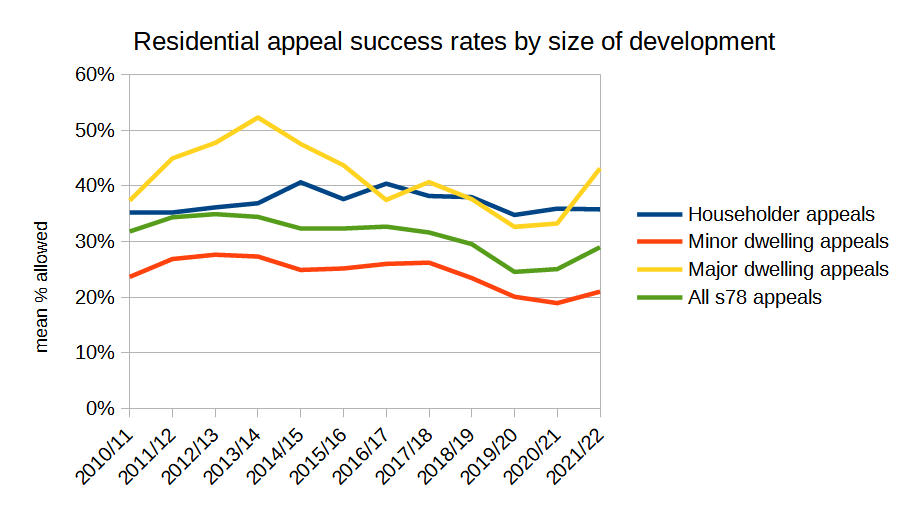Are residential appeal success rates returning to previous levels
With the Government promising a new NPPF, many practitioners are reminded of the heady days of the first NPPF a decade ago with appeal success rates of 34%-35%. Disappointment followed as success rates dropped to 21%-23% in 2019/20, followed by relief when appeal success rates returned to around 28%-29% in 2021/22. This begs the question, will appeal success rates return to the point when more than 3 in 10 appeals are allowed? Over the past year the overall success rate of all s78 appeals has stabilised – but this overall picture can be misleading.
Over the past year the overall success rate of all s78 appeals has stabilised – but this overall picture can be misleading.
Differences in appeal success by size of development
The more detailed graph below compares the overall figure for all s78 appeals (green line) with the success rates for major residential development (yellow line), minor residential development (red line) and householder appeals (blue line). This reveals a more varied picture, depending on the type of development. 
Major residential developments (yellow line) have fluctuated widely in success rates over the years, from an average of 52% success rates in 2013/14 when five year housing land supply concerns were at their height, falling down to an average of 33% of appeals allowed in 2019-2021. Last year saw a somewhat surprising uptick to success rates of 43% in 2021/22.
Minor residential developments (red line) involving 1-9 dwellings consistently have the lowest rates of success at appeal, with an average of only 21% allowed in 2021/22. Minor residential developments comprise nearly half of all appeals, so the low success rates for this type of development drags the overall average for all s78 appeals significantly downwards.
Householder appeals (blue line) have experienced much more stable appeal success rates of 35% - 41% over the past decade.
Figure 3: Percentage of appeals allowed for householder, minor and major residential developments
| Year | Householder |
Minor dwellings |
Major dwellings |
All s78 appeals |
| 2010/11 | 35% | 24% | 37% | 32% |
| 2011/12 | 35% | 27% | 45% | 34% |
| 2012/13 | 36% | 28% | 48% | 35% |
| 2013/14 | 37% | 27% | 52% | 34% |
| 2014/15 | 41% | 25% | 48% | 32% |
| 2015/16 | 38% | 25% | 44% | 32% |
| 2016/17 | 40% | 26% | 37% | 33% |
| 2017/18 | 38% | 26% | 41% | 32% |
| 2018/19 | 38% | 23% | 38% | 30% |
| 2019/20 | 35% | 20% | 33% | 25% |
| 2020/21 | 36% | 19% | 33% | 25% |
| 2021/22 | 36% | 21% | 43% | 29% |
Will appeals get easier to win?
A pessimist would predict appeal rates will remain around their current level, while an optimist might expect a return to the historic rule-of-thumb that a third of appeals will succeed. But which is more realistic?
I was struck by a quote from Jean Cocteau who wrote, "True realism consists in revealing the surprising things which habit keeps covered and prevents us from seeing." If we shake off our professional mindset and look afresh at the world around us, among the “surprising things” we see could be:
- The cost-of-living crisis is likely to positively impact public attitudes to development.
- Radical change seems more likely than 12 months ago.
- The vast majority of appeals have always been unsuccessful.
Although “hope never dies”, it pays to be brutally honest about the strengths and weaknesses of your case.

To find appeals that are relevant to you, see our Home page.

